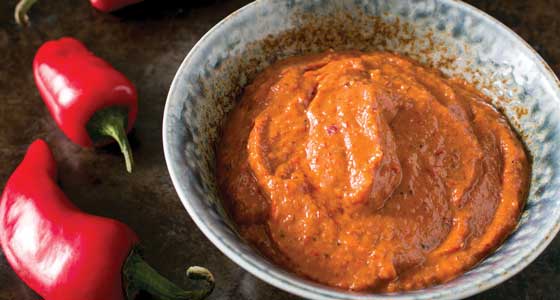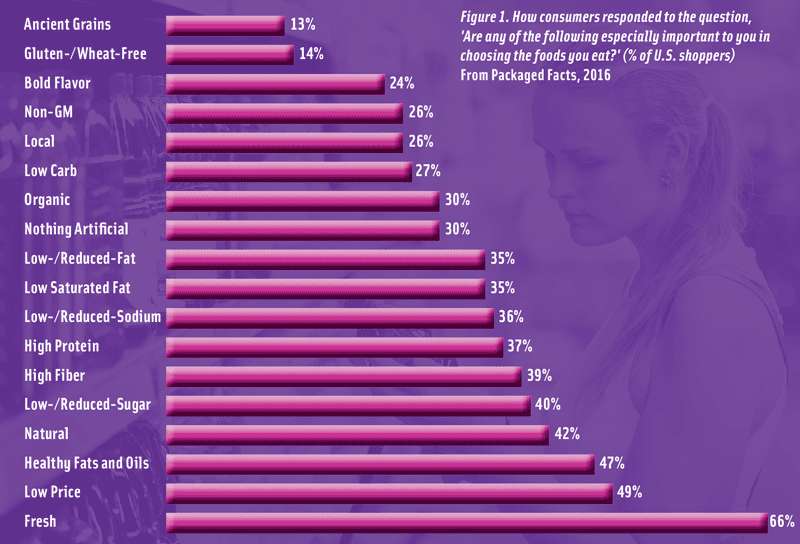Finding New Ways to Give Consumers What They Want
Plant-based protein, healthy fats and oils, and sodium-reduction options were among the high-profile ingredient trends at the IFT16 food expo.

U.S. Food and Drug Administration labeling actions, the demand for cleaner labels, interest in intense and ethnic flavors, plant-based eating patterns, and more aggressive—and alternative—health solutions were among the consumer and marketplace trends that drove innovation and activity on the IFT16 food expo floor.
An IFT16 Mintel presentation, “Free-From for All: Alternatives Are Ready for the Spotlight,” noted that 71% of U.S. adults say there are probably more harmful or excess ingredients in foods than manufacturers list on the ingredient label. A Packaged Facts national consumer survey confirmed that healthy fats/oils were especially important to 47% of consumers when choosing foods in 2016. In addition, natural was important for 42%; low/reduced sugar, 40%; high protein, 37%; organic and/or nothing artificial, 30%, not genetically modified (GM), 26%; and ancient grains, 13% (Figure 1).
Sodium and sugar reduction, nonhydrogenated formulation systems, GM-free ingredients, and broader nutrient additions to the nutrition label were among the regulatory-inspired opportunities showcased by IFT suppliers. Kikkoman’s natural umami-boosting flavor enhancers claim to reduce sodium by as much as 40%–50%. Savoury Systems showcased its SavourSalt, which dropped sodium levels by 34% in pulled pork and 50% in barbecue sauce. Cargill’s Alberger salt crystals, which are shaped like an inverted hollow pyramid, lower salt density and provide a burst of salty flavor in applications like snacks or chips.
The U.S. Dairy Export Council demonstrated that whey permeate and other dairy solids can also lend salty flavor to foods while reducing sodium 50%–70% by sampling a high-protein yogurt soup with only 410 mg sodium per serving. Lycored’s chefs created an Italian vinaigrette dressing with a 70% sodium reduction using the company’s SANTE tomato extract.
AAK offered live baking/confectionery demonstrations at the food expo to showcase its latest non-PHO fats and oils solutions as the industry moves toward nonhydrogenated process options. Low-fat breads, non-GM sunflower oil, and Dow’s two new plant-based solutions for reducing fat—one specific to meats—were other fat- and oil-based innovations.
Archer Daniels Midland announced a partnership with GLG Life Tech to bring non-GM stevia and monk fruit sweeteners to customers. Ciranda offered organic crystalline grape sugars. Petiva introduced Honeytose, a natural non-GM sugar present in honey. Carolina Innovative Food Ingredients presented new sweet potato ingredients that can replace artificial sweeteners and add a nutritional boost to baked goods, sauces, and other foods.
--- PAGE BREAK ---
Plants, Protein, and Health
From pulses—chickpeas, beans, lentils, and peas—to chia, flax, and quinoa, plant proteins were all the rage at IFT16. Watch for a new “made with pulses” symbol, available for products that list pulses in the top five ingredients or have a minimum of 5% in the final formulation. Pulses are a good source of protein, an excellent source of fiber, high in antioxidants, and rich in iron, potassium, and folate.
Sorghum, flax, kamut, wheat, and millet were among the sea of grains, seeds, and flours featured at this year’s food expo. Blue Diamond’s almond flours, sampled in Wedding Cake Mini Cupcakes, contained all the health benefits of whole almonds, which are high in protein, fiber, antioxidants, and healthy fats and are naturally gluten-free.
Mori-Nu Silken Soy Puree from Morinaga is another new, highly versatile high-protein ingredient perfect for conveniently increasing the protein content of beverages, sauces, salad dressings, and ice cream. Holland Food Valley sampled algae-based pesto pasta and burgers made of tomatoes or a combination of asparagus and lentils.
Innova Market Insights reported that vegetarian claims rose 60% on new foods and beverages globally from 2011 to 2015 while vegan launches rose 4.3% last year; 12% of new U.S. foods carried a gluten-free claim in 2015.
Less processed and whole food ingredients remain in vogue. Bunge announced its expeller-pressed oils/cold-pressed artisan oils. Future-Ceuticals introduced Premium Estate-Grown Hawaiian Coffee Fruit, which is higher in polyphenols and fiber than açai or wild blueberries.
Herbs and botanicals as well as flower pollen extract from Graminex moved further into the nutritional spotlight in Chicago along with plant-derived enzymes and a variety of yeasts. Thanks to the emergence of a fitness-focused mainstream consumer segment, it’s not surprising that leucine, which is essential for muscle development, and theanine, an amino acid analogue from green tea, received long overdue attention.
Probiotics and prebiotics continued to be among the hot ingredients. AIDP’s PreticX prebiotic is corn-derived. Sensus showcased organic inulin sourced from agave. A new survey from AIDP found that six in 10 consumers would be interested in buying products that contained both probiotics and prebiotics.
Culinary Charisma
Tate & Lyle served up food truck–inspired cuisine with global flavors, including a sweet street taco and a fiber-enriched summer mango gazpacho. Wow Butter has the taste, texture, and aroma of peanut butter but is gluten- and peanut-free.
This year’s IFT food expo was also about fun foods, intense flavors, and future food directions. Kikkoman’s Thai Chili Peanut Butter put a yummy twist on an old favorite. Blue Diamond raised the bar on snack bars, showcasing exciting new flavor concepts in mesquite, hot ginger, and honey-roasted flavors.
Mintel cited soursop, harissa, and turmeric as up-and-coming flavors, a trend it characterized under the banner “a sense of the intense.” In a presentation called “Senior Solutions: Developing Products for the Aging Consumer,” a Mintel presenter noted that catering to the tastes of Americans who are over the age of 50 should be a product development priority. According to Mintel, Italian is the ethnic cuisine consumed most frequently by older adults; it is chosen by 72% of those 55-plus, followed by Chinese, Mexican, and Japanese.
Synergy rolled out new cold brew coffee concentrates. Edamame cakes and yogurt kefir dips were other new product prototypes highlighted at the food expo. Watson showcased its clear forms of vitamin A and beta-carotene in a fortified spring water and offered a fortified creamer and new flavored edible glitter for big and little kids. DSM showed off Lolivita edible vitamin cups and nutrient-fortified, breath-freshening VitaminGum and SmartGum.
A number of food expo exhibitors, including Bell Flavors and Fragrances, provided product developers with inspiration for less mainstream international options. Bell featured Indian comfort foods such as a naan pizza topped with makhani sauce with tikka masala curry flavor, curry pimento cheese, and a sweet/spicy mango chutney. Other offerings from Bell included malai gola, an Indian summer dessert, and cold brew flavored coffees in vanilla cardamom and Indian spice flavors.
Novel concepts were in plentiful supply. Pet Flavors Inc. unveiled exciting new pet-specific flavors for cat and dog foods. Bug protein (i.e., cricket powder) made an appearance, and purple corn and jackfruit moved center stage.
A. Elizabeth Sloan, PhD, contributing editor, is president, Sloan Trends Inc., Escondido, Calif. ([email protected]).


